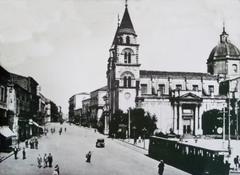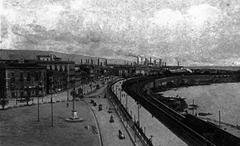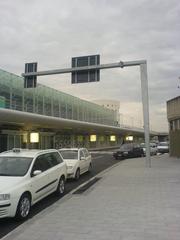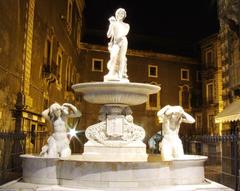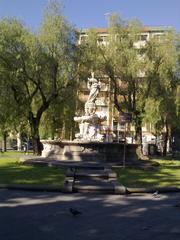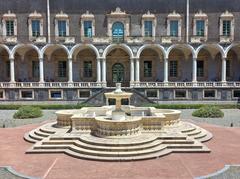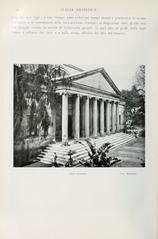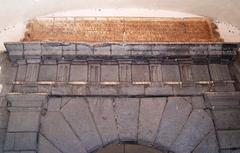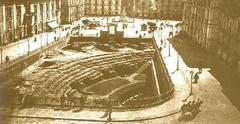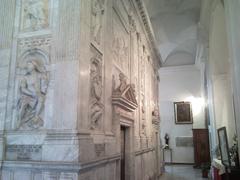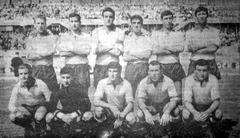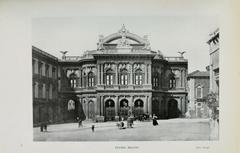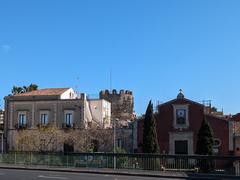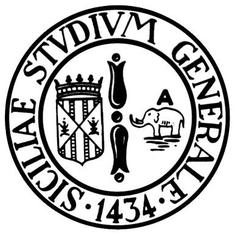Hernandez Palace Visiting Hours, Tickets, and Travel Guide: Catania Historical Sites
Date: 14/06/2025
Introduction to Hernandez Palace and Its Significance
Located in the vibrant heart of Catania, Sicily, Hernandez Palace—locally known as Palazzo Hernandez—stands as an enduring symbol of Sicilian Baroque architecture and aristocratic heritage. Erected in the early 18th century after the catastrophic 1693 earthquake, this palace embodies the city’s resilience and artistic rebirth. Its architectural features reflect a blend of Spanish Renaissance roots and the theatrical Sicilian Baroque style. Today, the palace’s legacy continues through the Palazzo Sangiorgio hotel, combining historical grandeur with modern comfort. With its ornate façades, contrasting black lava stone and white limestone, and proximity to landmarks like Piazza del Duomo and Via Etnea, Hernandez Palace is a gateway to the layered history of Catania. This guide offers up-to-date information on visiting hours, tickets, accessibility, and practical travel tips, as well as suggestions for exploring nearby attractions such as the Catania Cathedral, Roman Amphitheatre, and Mount Etna. Whether you are an architecture enthusiast or a cultural explorer, Hernandez Palace offers a compelling journey through Sicilian history. For planning and further research, see Wonders of Sicily, The Design Gesture, and My Global Viewpoint.
Table of Contents
- Introduction
- Origins and Historical Background
- Architectural Features and Cultural Role
- Visiting Hernandez Palace Today
- Itineraries and Practical Tips
- Dining, Nightlife, and Accommodation
- Frequently Asked Questions (FAQ)
- References and Further Reading
- Conclusion
Origins and Historical Background
Hernandez Palace was commissioned during the Spanish rule of Sicily by the prominent Hernandez family, reflecting their elevated status in post-Aragonese Sicily. Built in the Civita district near the present-day Piazza Cardinale Pappalardo, the palace originally functioned as a noble residence and a center of social and political life. Its Baroque reconstruction after the 1693 earthquake integrated local black lava stone, giving the façade its distinctive appearance (Wonders of Sicily). Over centuries, the palace witnessed the fluctuations of aristocratic fortunes before eventually falling into disrepair. In the 21st century, it was revitalized as the Palazzo Sangiorgio hotel, preserving key architectural details while offering modern amenities (Palazzo Sangiorgio Official Website).
Architectural Features and Cultural Role
Sicilian Baroque and Local Identity
Hernandez Palace exemplifies the Sicilian Baroque style, characterized by dramatic architectural contrasts, ornamental façades, and dynamic forms. The use of volcanic stone from Mount Etna contrasts sharply with lighter limestone or marble, creating a signature “black and white” look seen throughout Catania (The Design Gesture). Notable features include:
- Curved balconies and undulating cornices
- Lavish stucco, sculptural details, and wrought-iron railings
- Monumental entrance portals
Interior Layout
While much of the original interior has been adapted, historical accounts and comparisons with other Catania palazzi suggest the presence of:
- Central courtyards for light and ventilation
- Frescoed halls with mythological or historical scenes
- Grand staircases and inlaid marble floors
Role in Catania’s Social and Cultural Life
Historically, Hernandez Palace hosted significant social gatherings, cultural events, and political discussions, reinforcing its role as a hub for the Spanish and Sicilian nobility. Its proximity to major landmarks made it integral to city festivities, such as the annual Festival of Sant’Agata (Out of Office Mindset).
Visiting Hernandez Palace Today
Visiting Hours and Ticketing
Palazzo Hernandez / Palazzo Sangiorgio
- Opening Hours: Public spaces (restaurant, rooftop bar, spa) are typically open daily from 12:00 PM to midnight. Visiting hours for historical or cultural exhibitions usually run from 9:00 AM to 6:00 PM, Tuesday to Sunday, with last entry at 5:30 PM. Mondays and public holidays are reserved for private events or maintenance.
- Tickets: Access to hotel public areas is free; entry to exhibitions or guided tours generally ranges from €5 to €10, with discounts for students, seniors, and children. Advance booking is recommended, especially during festivals or special events (Official Site).
Accessibility and Visitor Amenities
- Physical Accessibility: The main entrance is at street level. Ramps, handrails, elevators, and accessible restrooms ensure ease of access for visitors with disabilities. Some historic sections may have limited access; contact the venue for specific needs.
- Visitor Facilities: Information desk, cloakroom, rest areas, temporary café, free Wi-Fi, and multilingual staff are available.
- Assistance: Guided tours tailored for sensory or cognitive disabilities, as well as service animal accommodation, are offered upon request.
Travel Tips and Best Time to Visit
- Best Season: Spring (April–June) and autumn (September–October) offer pleasant weather and lively city events.
- Getting There: The palace is centrally located and walkable from Piazza del Duomo, Via Etnea, and major transport hubs. AMTS city buses and the metro (Stesicoro, Giovanni XXIII stations) are nearby. Parking in the center is limited; public transport and walking are advised.
Guided Tours and Special Events
Guided tours provide insight into the palace’s history and art. Tours are available in English and Italian, with specialized options upon request. The palace also hosts seasonal exhibitions, concerts, and cultural programs—check the event calendar for details (EAA).
Photography and Media
Photography is generally permitted in public spaces, but flash and tripods may be restricted in certain exhibitions. Always check for signage or ask staff.
Nearby Attractions
Enhance your visit by exploring Catania’s historic center, home to remarkable Baroque and ancient sites:
- Catania Cathedral (Cattedrale di Sant’Agata): A Baroque masterpiece and the city’s religious heart.
- Piazza del Duomo and Elephant Fountain: The lively central square.
- Via Etnea: The city’s main thoroughfare, ideal for shopping and strolling.
- Roman Amphitheatre and Teatro Romano: Ancient entertainment venues revealing Catania’s roots.
- Palazzo Biscari: The city’s most lavish private palace.
- Villa Bellini: Catania’s oldest park, perfect for relaxation.
- Castello Ursino: A medieval fortress and museum.
- Monastery of San Nicolò l’Arena: A vast Baroque monastery open for guided tours.
- La Pescheria Fish Market: A lively local experience.
- Via dei Crociferi: A picturesque street lined with churches and palazzi.
- Beaches and Coastal Attractions: From black lava sand to golden beaches.
- Day Trips: Mount Etna and Taormina, High Heels and a Backpack: Nature and history beyond Catania.
Suggested Itineraries
Half-Day Itinerary
- Hernandez Palace tour
- Piazza del Duomo and Catania Cathedral
- Stroll along Via Etnea
- Roman Amphitheatre at Piazza Stesicoro
Full-Day Itinerary
- Morning: Hernandez Palace and Palazzo Biscari
- Lunch at La Pescheria market
- Afternoon: Castello Ursino and Museo Civico
- Evening: Villa Bellini or rooftop aperitivo
Two-Day Itinerary
- Day 1: Hernandez Palace, other Baroque palazzi, Monastery of San Nicolò l’Arena
- Day 2: Mount Etna or Taormina day trip
Three-Day Itinerary
- Day 1: Hernandez Palace, Via dei Crociferi, Roman Theatre
- Day 2: Parks, markets, and museums
- Day 3: Excursion to Mount Etna or Taormina
Practical Tips
- Walking: The historic center is best explored on foot; most attractions are within 10–15 minutes’ walk (High Heels and a Backpack).
- Public Transport: Useful for destinations outside the center.
- Midday Closures: Many sites close for a midday break (typically 1–4 pm).
- Dress Code: Modest attire required for religious sites.
- Seasonal Notes: June is warm and lively; spring and autumn are ideal for fewer crowds (Wanderlog).
- Advance Booking: Recommended for guided tours and popular exhibitions.
Dining, Nightlife, and Accommodation
- Local Cuisine: Enjoy arancini, pasta alla Norma, and fresh seafood at local trattorias.
- Nightlife: Popular spots like First Lounge Bar and rooftop bars along Via Etnea offer music and city views (Cheerful Trails).
- Accommodation: Choose from luxury (Palazzo Marletta Luxury House Hotel), mid-range (Hotel Biscari), or budget (I Vespri), all within walking distance (The Broke Backpacker).
Frequently Asked Questions (FAQ)
Q: What are Hernandez Palace visiting hours?
A: Typically 9:00 AM to 6:00 PM, Tuesday to Sunday (last entry 5:30 PM). Closed Mondays and public holidays; check the official website for updates.
Q: How can I buy Hernandez Palace tickets?
A: Tickets are available on-site and online; advance booking is recommended for peak times.
Q: Are guided tours available?
A: Yes, daily at 10:00 AM, 2:00 PM, and 4:00 PM. Tours in English and Italian; book ahead.
Q: Is Hernandez Palace wheelchair accessible?
A: Most areas are accessible with ramps and elevators. Contact staff for specific requirements.
Q: Are there special events or exhibitions?
A: Yes, check the event calendar on the official site for current schedules.
Q: Can I take photos inside Hernandez Palace?
A: Photography without flash is generally allowed, except where restricted.
Q: How do I get to Hernandez Palace?
A: Easily accessible by foot, public transport, or taxi from central Catania. Bus stops and metro stations are nearby.
References and Further Reading
- Visiting Hernandez Palace in Catania: History, Tickets, and Travel Tips (Wonders of Sicily)
- Hernandez Palace Catania: Visiting Hours, Tickets & Historical Guide (The Design Gesture)
- Guide to Hernandez Palace Visiting Hours and Nearby Attractions in Catania (My Global Viewpoint)
- Hernandez Palace Visiting Hours, Tickets, and Visitor Guide | Catania Historical Sites (Official Site)
- Hernandez Palace Catania: Visiting Hours, Tickets & Historical Guide (European Architectural Association)
Conclusion
Hernandez Palace, now represented by the sophisticated Palazzo Sangiorgio, remains an essential destination for anyone seeking to experience the historical and cultural richness of Catania. Its well-preserved Baroque architecture, accessible facilities, and prime location near the city’s most treasured landmarks make it a highlight of any Catania itinerary. Whether attending a cultural event, joining a guided tour, or exploring the vibrant surroundings, visitors will find themselves immersed in a narrative that bridges Sicily’s illustrious past and dynamic present. For the best experience, check current opening hours, book guided tours in advance, and consider visiting during spring or autumn for optimal weather and local festivities. For additional resources, download the Audiala app and consult official tourism portals for updates.
Plan your visit and discover the perfect blend of history and modern hospitality at Hernandez Palace.
